Content
70 years of the patent office in Munich, part 1
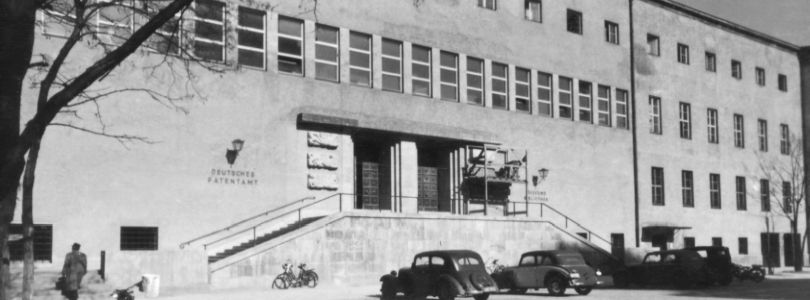
The German Patent Office in the library wing of the Deutsches Museum, 1949
How it happened that the patent office is located on the banks of the river Isar and Munich became the centre of industrial property protection
Exactly 70 years ago saw the beginning of Munich’s rise to become the European capital for the protection of innovations: On 1 October 1949, the German Patent Office began operations in the Bavarian capital. But how did the office, which had been founded in 1877 as the Imperial Patent Office (Kaiserliches Patentamt) in Berlin, end up on the banks of the Isar river?
Berlin, February 1945. A few days ago, the Reichspatentamt (Patent Office of the German Reich) had been severely hit by allied bombs. An examiner named Dr Kalix described the situation in the office in a letter to colleagues deployed in combat:
"On the 30th (January 1945) only few staff were on duty, as almost all means of transport were cancelled. The journey to the office was also dangerous, because across the street some houses were burning to the cellar (…). Those who had heroically struggled through to their rooms usually had to turn back, since it was impossible even to step into the rooms, because the furniture was completely smashed and the floor and walls were studded with penny-sized glass fragments. (…) Some colleagues have become cave dwellers, i.e. they only have cardboard windows and have to work all day under artificial light. (…)
But it became colder and colder outside, the thermometer dropped almost to zero and some prophets of doom were already calculating when the first radiator would burst. On Friday (18 February) some rooms were ready for ice-skating. (…) This morning, sand was scattered far and wide in the office building so that it was possible to move forward."
Library in a salt mine
At the end of 1943, at the latest, with the increasing intensity of bombing raids on Berlin, the Reichspatentamt had begun to bring files outside the city to safety. 180,000 files were shipped on the Spree-Oder canal to a monastery in Silesia, where they were destroyed by fire towards the end of the war. Large parts of the library of the Reichspatentamt (at least 250,000 volumes) were transferred to Heringen in Hesse and stored in a potash salt mine.
A few days after Dr Kalix had reported on the conditions in the bombed-out building, the Reichspatentamt in Berlin was closed. It was 21 April 1945, a Saturday. One day later the Russian army occupied the building.
After the end of the war, the Allies divided Germany and Berlin into four occupation zones; from 4 July 1945, the Reichspatentamt was located in the American sector. It is estimated that the office still housed some 145,000 pending patent applications at that time. An American team of experts, the Field Intelligence Agency, Technical (FIAT), seized these files. The team was headed by Richard Spencer, who had been a patent attorney in Chicago before his war mission.
The time without a patent office
After the collapse, a time began for Germany when there was no patent office. In view of the massive destruction and the mammoth task of reconstruction, industrial property rights were initially not among the most urgent problems in the occupied country. "For the moment, Germany is kaput and the German patent system is also kaput,” wrote Spencer as late as 1949 (“Journal of the Patent Office Society").
The reestablishment of a patent system was closely linked to the respective occupation zones: While the East, occupied by Russia, went its own way during the emerging Cold War, only the Americans and the British in the three Western occupation zones were in agreement that industrial property protection had to be reintroduced quickly. In these two zones, the plans for a new patent office gradually became more concrete.
On 1 January 1947, the British and American sectors combined to form the "Bizone” and founded the “Economic Council of the United Economic Area". On 5 July 1948, this council set the course for the reconstruction of industrial property rights in western Germany: From 1 October 1948, it was again possible to apply for patents or utility models for inventions and register trade marks. Two receiving offices were set up in Darmstadt and Berlin.
Flood of applications in Darmstadt
Especially the receiving office in Darmstadt recorded an enormous number of applications with 56,591 filed patent applications within twelve months – even more than in the last year of peace (1938) at the then Reichspatentamt (56,217)! In Berlin, after all, as many as 4,411 patent applications were filed during that period. Among the Darmstadt applications of that time were "classics" such as the screw-in studs by Alexander Salot or the special folding method for ![]() street maps by Gerhard Falk .
street maps by Gerhard Falk .
Thus the foundation of a "real" patent office in the West was already in the air. But where should it be located? At that time, most of the qualified former staff still lived in Berlin, the site of the severely damaged headquarters. But the situation in the enclave in the “Soviet-occupied zone” was considered precarious after the Russian blockade of the western sectors in 1948/49.
Darmstadt had built up great hopes, as it had to offer a technical university next to the new receiving office, where some former patent office staff were now employed, and it was located in the centre of Germany (at that time many people assumed that the neighbouring Frankfurt would become the federal capital). But Stuttgart, Hamburg, Cologne and Minden also wanted the office – and of course Berlin.
"It is impossible to overestimate the importance of the patent office."
Bavaria was determined that Munich should host the patent office. On 16 April 1948, the Bavarian Council of Ministers spoke about it for the first time. Munich mayor Dr Karl Scharnagl declared that the city was extremely interested in getting the bizonal patent office. Scharnagl suggested that the Deutsches Museum should host the patent office, but also pointed out that there might be problems with the Technische Hochschule (Technical University) and the University, which were using the rooms at that time.
The then Bavarian prime minister, Dr Hans Ehard, was pleased about the interest shown by the city. These things should not only be viewed from the present point of view and also not only with regard to the existing difficulties, it says in the minutes of the meeting. Rather, it was necessary to think about the accusations that would be made in ten years’ time if one missed out on a unique opportunity now, said Ehard. In times like those, it was necessary to take certain risks, the Bavarian prime minister said and added that the patent office could exert an extraordinary attraction and its importance could not be overestimated. ![]() (Bavarian Council of Ministers meeting No. 27, 16 April 1948) (in German).
(Bavarian Council of Ministers meeting No. 27, 16 April 1948) (in German).
Why Munich?
The reasons that spoke in favour of Munich: Not only extensive libraries and scientific research institutions were located here but, in addition to the Technische Hochschule and the world’s largest technology museum (Deutsches Museum), a number of big companies, such as Siemens, had also settled here after the end of the war.
During the Nazi era, the NSDAP, whose entire administration and sub-institutions were located in Munich, had also centralised its invention bureaucracy on the banks of the Isar river, e.g. the "Hauptamt für Technik der NSDAP" (Central Office for Technology of the NSDAP), which used the premises of the "Bayerischer Polytechnischer Verein" (Bavarian Polytechnic Association) in Erhardstraße near the Deutsches Museum.
In addition, Bavaria was able to point out that the future federal state of Bavaria was after all also entitled to accommodate an important institution of the emerging federal republic according to the logic of federalism. This decision for Munich was prepared by Walter Strauß, later State Secretary in the Federal Ministry of Justice, and Hans Wellhausen, Chairman of the Patent Law Committee in the Economic Council of the Bizone.
Difficulties with the rooms
It soon became apparent that Munich’s efforts would be crowned with success. But it was not so easy to solve the problems with the rooms. Half a year later, when the Bavarian Council of Ministers discussed the subject again, it was said that "a number of difficulties still existed and, above all, that the universities were fighting with all their might against vacating the Deutsches Museum".
Until the end of 1949, the University and the Technische Hochschule had legally rented part of the rooms of the Deutsches Museum intended for the patent office. Bavarian Prime Minister Ehard then emphasised once again “that a solution had to be found by all means, as quickly as possible, since they had finally succeeded, after many failures, in bringing such an important bizonal office as the patent office to Munich” (meeting of the Bavarian Council of Ministers No. 50, 23 November 1948).
The Bavarian state even stepped into the breach to help with the rent: The Deutsches Museum demanded a rent of three deutschmarks (DM) per square metre, but the patent office was to pay only DM 1.75. The Bavarian State Government paid the difference. At the same time, it assured the universities that replacement premises would be found.
Narrow vote
On 17 December 1948, the decision in favour of Munich was made when the Economic Council passed the "Act on the Establishment of a Patent Office" (Gesetz über die Errichtung eines Patentamts) in its third reading and, at the same time, voted on the seat of the patent office.
Munich prevailed over Darmstadt in a vote of 43 to 40. The Economic Council decided that the authority subordinate to it should be called the “German Patent Office in the United Economic Area”. The receiving offices in Darmstadt and Berlin were to be closed down.
“One of the crucial factors for choosing Munich were the better premises for accommodating the library of the patent office, which is currently stored in a potash mine in central Germany, as well as more suitable offices for the civil servants and employees of the patent office,” commented the "Süddeutsche Zeitung" (SZ) newspaper on this decision (SZ 18 December 1948).
However, at first, the Act did not enter into force because the Allies did not consent to it. The "Süddeutsche Zeitung" reported that the French military government was “very critical” of the establishment of a German patent office and considered it “premature”; it wanted a European approach. “In this context, considerations pointed to a European Patent Office in Geneva, favoured by France” (SZ 27 January 1949).
Trouble with the universities
However, it was still not possible to resolve the question of rooms: At the meeting of the Bavarian Council of Ministers of 5 January 1949, it was reported that "great difficulties had arisen, because the rectors of the University and the Technische Hochschule (...) had claimed that the contract of the Technische Hochschule with the Deutsches Museum ran until 1 September 1949 and they refused to leave the building before that date. Since the patent office was scheduled to open on 1 July 1949 and all rooms had to be occupied within the course of that year, the situation was very unpleasant”. However, the rector of the Technical University had agreed to move out “if he got DM 200,000 to 300,000 for an extension".
According to the minutes, Bavarian Prime Minister Ehard got frustrated and said that it was simply hopeless because people were always causing trouble when someone tried to bring an important office or other company which was valuable for Bavaria to Munich and added that, finally, the approval of the Economic Council in Frankfurt had been achieved and immediately the trouble started again. Indeed, it was apparently impossible to stand up for anything at all.
Nevertheless, it was also possible to record at this meeting that the staff in charge of setting up the patent office had arrived in Munich and that a meeting with the new mayor Thomas Wimmer “had been satisfactory as far as the offices for the civil servants of the patent office in Munich were concerned”.
By the way, the Bavarian Minister of Education and Cultural Affairs, Dr Alois Hundhammer, first suggested the site of the former military barracks of the "Schwere Reiter" as an alternative location. This is the site where the new patent office was actually built later (Bavarian Council of Ministers meeting no. 55, 5 January 1949).
Progress is being made
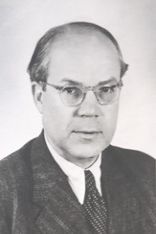
The first President of the post-war patent office, Professor Dr Eduard Reimer
So while the Bavarian government was still pondering over problems, the "Süddeutsche Zeitung" was celebrating Munich’s success: “It is gratifying that Munich was chosen to provide a home for the new German Patent Office. The city does not only have a large and prestigious technical university, but also a number of well-known technical academies and schools. The number of patent office staff is expected to range from 600 to 800. It is expected that a large proportion of the staff will be local residents, i.e. people from Munich. The experienced examiners and the technical and legal members of the former office are to be taken over” (SZ 11 January 1949).
Then in April the newspaper reported: “Fast progress is being made on the completion of the rooms for the patent office, which is due to move into the museum in June. More than half a million volumes of documents, stored in stacks that are several meters high, are already waiting in individual rooms for their future use. They will end their odyssey here, a journey that led from Berlin to the mine shafts of central Germany and later to various locations in western Germany” (SZ 12 April 1949).
On 24 May 1949, the three western occupation zones united to form the Federal Republic of Germany. In August, the first elections of the Bundestag took place, which met for its first session in September.
On 12 August 1949, the “Act on the German Patent Office” finally came into force, section 1 of which specified Munich as seat of the patent office. As compensation, Darmstadt received central authorities of the German Federal Post Office. On 25 August 1949, Hermann Pünder, Chairman of the Administrative Council of the United Economic Area, announced that the new German Patent Office would open on 1 October 1949.
Waiting for the patent office
In July 1949, the "Süddeutsche Zeitung" wrote: "100,000 inventors are waiting for the patent office. Since April, a staff of about 100 in charge of setting up the patent office has been working at the Deutsches Museum. (...) Around 40 rooms have now been completed for the patent office in the library building of the Deutsches Museum; intensive efforts are still being made to complete the rooms intended to be open for the public as well as the archive and the library. At present, the shelves of the library are being mounted, which, lined up side by side, would cover a considerable 19 kilometres in length".
The office would "attract experts from all over the world who would handle their patent affairs in Munich," the paper rejoiced and reported on the already pretty healthy self-confidence of the new office: “There is still uncertainty about the future status of the patent office, which is temporarily subordinate to the Legal Office of the Administration of the United Economic Area and formerly was subordinate to the Ministry of Justice of the German Reich. Its senior management believes that autonomy would indeed be suitable for the office as the only large technical authority” (SZ 19 July 1949).
Trouble in Berlin
Berlin in particular was by no means happy about the decision in favour of Munich. The head of the Berlin receiving office, Dr Johannes Eylau (former President of the Reichspatentamt, who had been dismissed by the Nazis in 1933), told the SZ that he hoped “that the move of the Federal patent office to Munich would not be a final decision.” Several Berlin newspapers opposed the establishment of the patent office in Munich. The "Tagesspiegel" called it a measure “of obvious and political illogicality,” according to the SZ (25 August 1949).
"Greatest economic importance": the opening in Munich
However, the time had finally come: “The fact that it has been jointly recognised by the representatives of the German industry, by the officials of the military government and by the German authorities involved that the German people need strong protection of their intellectual achievements, especially today, and that these are one of their most valuable assets for safeguarding their future lives, has led to the mobilising of all forces and ultimately to success,” said Federal Minister of Justice Dr Thomas Dehler. On 1 October 1949, a Saturday, the German Patent Office started operations in the rooms of the Deutsches Museum with 423 staff. Professor Dr Eduard Reimer was appointed President and stayed at the helm of the office until his death in 1957.
The political celebrities of the young republic expressed their congratulations: Federal Chancellor Konrad Adenauer said that he was “particularly gratified” that the patent office was the first higher federal authority in the Federal Republic of Germany to start its operations. It would be “even more important than in the past”.
"The new beginning is based on a rich and recognised tradition – it will be felt by its supporters as strength and an obligation," Federal President Theodor Heuß wrote. "The opening of the German Patent Office is of the greatest economic importance," stressed Federal Minister of Economic Affairs Ludwig Erhard (special issue of the official gazette "Blatt für Patent-, Muster-, und Zeichenwesen" [BlPMZ] on the occasion of the opening, 1 December 1949.)
"This marks the end of one of the saddest chapters in post-war history," wrote the "Süddeutsche Zeitung" on the occasion of the opening. “Four and a half years after all German foreign patents had been confiscated and allied special forces had lifted the very last veil of patent and research secrets, more than 60,000 new patent documents are awaiting processing in Munich. (...) After four and a half years of total legal uncertainty, German inventors will again be able to calmly take their work out of the drawer, file an application and have it patented.”
And sure enough, that’s what happened: “We’ve been inundated with work,” President Reimer was quoted by the "Süddeutsche Zeitung". “It doesn’t look as if the flood of applications is subsiding. Apparently the inventors in Germany grow on trees” (SZ 27 September 1949).
"Europe’s patent capital"
Today, Munich is home not only to the DPMA, the largest national patent office in Europe, but also to the European Patent Office, the Federal Patent Court, the German Chamber of Patent Attorneys as well as several large and small patent law firms and the Max Planck Institute for Innovation and Competition.
"Munich is undoubtedly Europe’s patent capital. Thus the city absolutely plays a key role for the innovative strength of the German and the European economy," said DPMA President Cornelia Rudloff-Schäffer on the occasion of the anniversary. "Munich is an ideal location for us as a large federal authority and service provider for industry".
The complete articles series
- Part 1: How it happened that the patent office is located on the banks of the river Isar and Munich became the centre of industrial property protection
- Part 2: The patent office and Munich: The building, the arts and the media
- Part 3: (will be published in December)
Pictures: Deutsches Museum, Fotoarchiv Werra-Kalibergbau-Museum Heringen, DPMA, Deutsches Museum, Deutsches Museum, DPMA, Deutsches Museum, DPMA, Deutsches Museum
Last updated: 23 January 2024
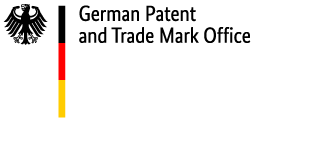
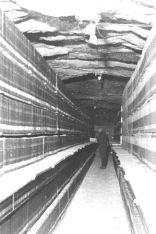
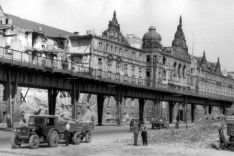
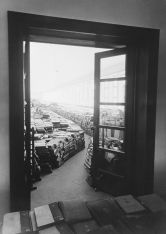
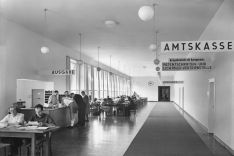
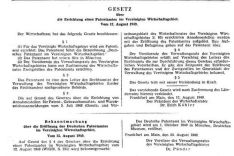
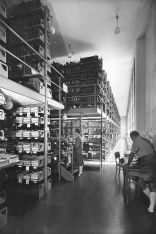
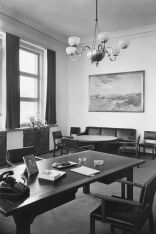
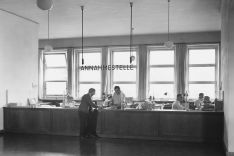
Social Media